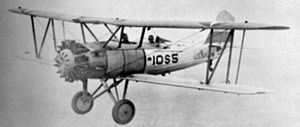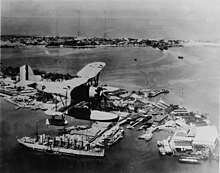Vought O2U Corsair
| O2U Corsair | |
|---|---|
 O2U-4 Corsair | |
| General information | |
| Type | Observation |
| National origin | United States |
| Manufacturer | Vought |
| Primary users | United States Navy |
| Number built | 580 |
| History | |
| Introduction date | 1926 |

The Vought O2U Corsair is a 1920s biplane scout and observation aircraft. Developed by Vought Corporation, the O2U was ordered by the United States Navy (USN) in 1927. Powered by a 400 hp (298 kW) Pratt & Whitney R-1340 engine, it incorporated a steel-tube fuselage structure and a wood wing structure with fabric covering. Many were seaplanes or amphibians.
Design and development
[edit]Two prototypes were ordered in 1926 and tested by the Navy Trial Board before the first production batches were ordered. In 1927, a total of 291 O2Us were produced. The O2U-2, -3 and -4 were ordered in 1928 with minor changes. By 1930 they were being superseded by the O3U which was basically similar to the O2U-4, one variant of which was fitted with the Grumman float, and were manufactured until 1936. A total of 289 were built.[1] Many of them had cowled engines and some had enclosed cockpits.
Operational history
[edit]The 600-690 hp (448-515 kW) Pratt & Whitney R-1690-42 Hornet engine was used to power Corsairs designated SU-1 to SU-4. The change in designation reflected their role as scouts (their larger engines and heavier weight precluded their use as floatplanes, and USN examples were only used on wheels from either carrier decks or land bases). A total of 289 SU designated aircraft were built for the USN. No fewer than 141 Corsairs were still serving with the US Navy and Marines when the US entered World War II.[citation needed]
Export versions included the Corsair V-65F, V-66F and V-80F for the Argentine Navy, the V-80P for the Peruvian Air Force, and the V-85G for Germany.[1] China purchased Corsair variants V-65C and V-92C. Brazil purchased 36 aircraft V-65B, some hydroplanes V-66B and 15 V-65F.
In March 1929, Mexico purchased 12 armed aircraft O2U-2M versions with the 400 hp (300 kW) Wasp engine to quell a military coup; Mexico then built 31 more units under licence, and called them Corsarios Azcárate O2U-4A. In 1937, Mexico purchased 10 V-99M equipped with the Pratt & Whitney R-1340-T1H-1 550 hp Wasp engine, some of them may have been sent to Spain.[2]
China purchased the 42 export versions of O2U-1 from 1929 to 1933, and 21 export versions of O3U between 1933 and 1934 and they saw extensive bombing actions. The O2U-1 versions participated in the Central Plains War and in the January 28 Incident against Japanese targets, while the O3U versions first participated in the Battle of Pingxingguan to support the Chinese ground forces, and later against the Japanese targets in Shanghai.
Peru purchased two Vought OSUs which were designated UO-1A. Later, in 1929, 12 O2U-1 were acquired. Used first as trainers, they saw action against APRA rebels in the northern areas of the country, and against Colombian ships and aircraft during the Colombia-Peru War. None were lost due to enemy fire, but several were destroyed due to accidents. These aircraft were also used for light bombing and casualty evacuation by the US Marine Corps during the intervention in Nicaragua in the late 1920s.
Thailand used their Corsairs in the Franco-Thai War and in the Battle of Ko Chang against the French Navy.[3]
The most famous "combat" operation of this aircraft was shooting the original King Kong off of the Empire State Building.[citation needed]
The name "Corsair" was used several times by Vought's planes; the O2U, Vought SBU Corsair in 1933, F4U in 1938, and the A-7 Corsair II in 1963.
Variants
[edit]- XO-28
- Single example taken on charge by the U.S. Army Air Corps for evaluation with serial 29-323, Wright Field Project Number P-547,[4] powered by a 450 h.p. R-1340-C engine. Destroyed in hangar fire at Wright Field, Ohio, 18 March 1930.[5]
- O2U-1
- two prototypes followed by 130 production aircraft for USN with interchangeable wheel/float landing gear and 28 aircraft for other customers. 450 hp (336 kW) Pratt & Whitney R-1340-88 Wasp engine
- O2U-2
- 37 built, increased span and larger rudder
- O2U-3
- 110 built (30 for export), revised wing rigging, redesigned tail surfaces and Pratt & Whitney R-1340-C engine
- O2U-4
- 43 built (1 for export. Also seven civilian O2U were built), similar to O2U-3 but with equipment changes
- O3U-1
- 87 built as observation seaplanes incorporating Grumman amphibious float[6][7]
- O3U-2
- 29 built, strengthened airframe, Pratt & Whitney R-1690 Hornet engine
- O3U-3
- 76 built, 550 hp (410 kW) Pratt & Whitney R-1340-12 Wasp engine.
- O3U-4
- 65 built, Pratt & Whitney R-1690-42 Hornet engine.
- XO3U-5
- test aircraft with Pratt & Whitney R-1535 engine
- XO3U-6
- test aircraft converted from O3U-3 with NACA cowling and enclosed cockpits
- O3U-6
- 32 built, 16 with Pratt & Whitney R-1340-12 Wasp and 16 with Pratt & Whitney R-1340-18 Wasp engines
- SU-1
- Scout version of the O3U based on the O3U-2, 28 built[8]
- SU-2
- Scout version of the O3U based on the O3U-4, 53 built[8]
- SU-3
- Variant of the SU-2 with low-pressure tires, 20 built[8]
- XSU-4
- SU-2 converted as a prototype SU-4 variant with a 600 hp R-1690-42 engine, later became an SU-4.
- SU-4
- SU-4 re-engined with a 600 hp R-1690-2 engine, 41 built[8]
- One United States Navy O2U-3 evaluated by the United States Army Air Corps.
- Vought V-65B
- Export version for Brazil - 36
- Vought V-65C
- Export version for Nationalist China
- Vought V-65F
- Export version for Argentine Navy
- Vought V-66B
- Export version for Brazil
- Vought V-66E
- Export version, one evaluated by the Royal Air Force
- Vought V-66F
- Export version for Brazil - 15, and Argentine Navy
- Vought V-80F
- Export version for Argentine Navy
- Vought V-80P
- Export version for Peruvian Air Force
- Vought V-85G
- Export version for Germany
- Vought V-92C
- Export version for Nationalist China
- Vought V-93S
- Export version of the O3U-6 for Thailand
- Vought V-99M
- Export version for Mexico
- TNCA Corsario Azcárate
- 31 O2U-4A aircraft built under license in Mexico.
- Vought AXV1
- A single O2U supplied to the Imperial Japanese Navy Air Service for evaluation in 1929.
Operators
[edit]

- Chinese Nationalist Air Force
- Chinese Red Army - One V-65-C1 was obtained from a defection during the Long March and named "Lenin".
- Cuban Air Force - received at least 14 O2U-1A and O2U-3As from 1929.[9]
- Dominican Air Force - received one O2U-1 and two O2U-3SDs.[10]
 Germany - commercial variant (V-85G) used to deliver mail from the ocean liners SS Bremen and SS Europa
Germany - commercial variant (V-85G) used to deliver mail from the ocean liners SS Bremen and SS Europa Japan
Japan
- Royal Air Force, one V.66E for evaluation
- United States Army Air Corps one for evaluation
- United States Navy
- United States Marine Corps
- United States Coast Guard
- Royal Thai Air Force had 70 operational aircraft at the time of the French-Thai War.
Specifications (SU-4 Corsair)
[edit]
Data from The Complete Encyclopedia of World Aircraft
General characteristics
- Crew: Two
- Capacity: 500 lb (227 kg)
- Length: 27 ft 5.5 in (8.37 m)
- Wingspan: 36 ft 0 in (10.97 m)
- Height: 11 ft 4 in (3.45 m)
- Wing area: 337 sq ft (31.31 m2)
- Empty weight: 3,312 lb (1,502 kg)
- Max takeoff weight: 4,765 lb (2,161 kg)
- Powerplant: 1 × Pratt & Whitney R-1690-42 Hornet radial, 600 hp (447 kW)
Performance
- Maximum speed: 167 mph (269 km/h, 145 kn) at sea level
- Range: 680 mi (1,094 km, 591 nmi)
- Service ceiling: 18,600 ft (5,670 m)
- Power/mass: 0.13lb/hp (0.21 kW/kg)
Armament
- Guns: 3x .30 cal (7.62 mm) Browning machine guns, two forward firing in upper wing and one on a trainable mount in rear cockpit
- Bombs: 4x 116 lb (53 kg) or 10 30 lb (14 kg) bombs under lower wings
References
[edit]Citations
[edit]- ^ a b Eden and Moeng 2002
- ^ "Corsarios Mexicanos" (in Spanish). Archived 2009-03-26 at the Wayback Machine portalaviacion.vuela.com. Retrieved: 18 January 2011.
- ^ Royal Thai Air Force, Bangkok, 1976: The History of the Air Force in the Conflict with French Indochina.
- ^ "1922-1929 USAAS-USAAC Serial Numbers".
- ^ Andrade, John M. U.S. Military Aircraft Designations and Serials since 1909. Earl Shilton, Leicester: Midland Counties Publications, 1979. ISBN 0-904597-22-9, page 138.
- ^ "New Navy Planes Land On Water Or Deck." Popular Science, February 1933.
- ^ "Eyes of the Fleet as seen during Maneuvers." Popular Mechanics, March 1933.
- ^ a b c d "Vought". Aerofiles. Retrieved: 18 January 2011.
- ^ Hagedorn 1993, p. 10.
- ^ Hagedorn 1993, p. 96.
Sources
[edit]- Eden, Paul; Moeng, Soph (2002). The Complete Encyclopedia of World Aircraft. London, England: Amber Books Ltd. ISBN 0-7607-3432-1.
- Hagedorn, Daniel P. (1993). Central American and Caribbean Air Forces. Tonbridge, Kent, UK: Air-Britain (Historians) Ltd. ISBN 0-85130-210-6.
- Lezon, Ricardo Martin & Stitt, Robert M. (January–February 2004). "Eyes of the Fleet: Seaplanes in Argentine Navy Service, Part 2". Air Enthusiast (109): 46–59. ISSN 0143-5450.
- Young, Edward M. (1984). "France's Forgotten Air War". Air Enthusiast. No. 25. pp. 22–33. ISSN 0143-5450.
Further reading
[edit]- Núñez Padin, Jorge Felix (2009). Núñez Padin, Jorge Felix (ed.). O2U-1A & V65F / V66F Corsair. Serie Aeronaval (in Spanish). Vol. 19. Bahía Blanca, Argentina: Fuerzas Aeronavales. Retrieved 2014-08-21.
 Media related to Vought O2U Corsair at Wikimedia Commons
Media related to Vought O2U Corsair at Wikimedia Commons
